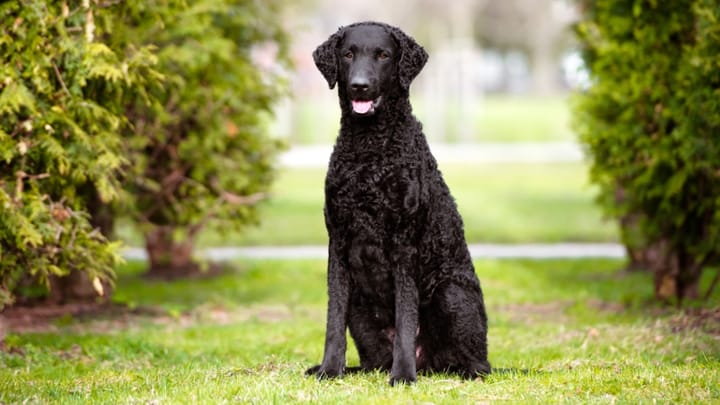Curly-Coated Retriever
Other names : Curly, CCR


The Curly-Coated Retriever was bred in England. It was used for retrieving game and waterbirds and is the tallest of the retriever breeds. The name comes from its distinctive curly coat. The tight curls repel water and burrs (dry seeds that have hooks or teeth) which are often found near lakes and ponds frequented by waterbirds. Like any retriever breed, the curly coated is a lively, friendly, soft-natured animal. They make excellent family pets.
|
Life expectancy |
The Curly-Coated Retriever has a life expectancy of between 10 and 12 years |
|
Temperament |
|
|
Size |
Medium
|
|
Adult size |
Female
Between 24 and 25 in
Male
Between 26 and 27 in
|
|
Adult weight |
Female
Between 53 and 66 lb
Male
Between 62 and 75 lb
|
|
Coat colour
Black or brown (liver). |
Black Brown |
|
Type of coat
Single smooth layer, short, tight curls. |
Short Wavy |
|
Eye colour
Dark brown. |
Brown
|
|
Purchase price |
The Curly-Coated Retriever costs between £550 and £775 |
These dogs have a very low tolerance for boredom.
Training should always be fun. Treat it like a game.
Unless well socialised, these dogs have an exceptionally high prey drive.
More details about the Curly-Coated Retriever
Curly-Coated Retriever: Origins and history
The Curly Coated is thought to be one of the oldest retriever breeds. Because of its curly coat, some experts believe it was cross-bred from the Poodle. There’s no definitive proof, but, given that the Poodle is also a water dog, such speculation is well within the bounds of possibility. Like many working dogs, its numbers dropped during the beginning of the 20th century as more rural settlements were swallowed up by waves of industrialisation. However, breeding groups were set up in the 1930s and the Curly Coated became a popular household pet in a range of countries including Sweden, Australia, and the USA. Despite being a British breed, the Curly Coated is a rare choice for UK dog owners.
Physical characteristics of the Curly-Coated Retriever
The Curly-coated Retriever is slightly taller and leaner than other retriever breeds. The most obvious feature is their curly coat. They have a robust, long, athletic body, and a well-balanced gait. They have well proportioned, flat and strong jaws, a medium length muzzle and short, flat ears. The tail is quite short, and covered with adorable little curls.
FCI classification of the Curly-Coated Retriever
-
Group 8 - Retrievers - Flushing Dogs - Water Dogs
-
Section 1 : Retrievers
Curly-Coated Retriever: Characteristics
Curly-Coated Retriever: Behaviour
Training a Curly-Coated Retriever
One of the easiest dogs to train, they love to please their owners. However, training must be fun and engaging. These sensitive dogs require a gentle and patient hand.
Curly-Coated Retriever: Lifestyle
Breed compatibility Curly-Coated Retriever
Curly-Coated Retriever: Purchase price
Between £550 for Non KC Registered dogs, and £775 for KC Registered dogs. Looking after a dog of this size typically costs between £80 to £110 a month, including food, medical/insurance, and incidental expenses.
Curly-Coated Retriever: Grooming
A weekly brush and a trim once every few months should be enough.To avoid frizzy hair, a little moisture should bring it back to shape.
Curly-Coated Retriever: Health
This is a very healthy and well-bred dog with an average life expectancy of 11 years.
The Curly Coated is very strong and robust. They are bred to thrive in rugged, rural environments, and are lean, athletic, and well-built.
They shed heavily during warmer months, so can tolerate the heat very well.
A tight, curly coat protects this dog from the cold and the rain. It forms a waterproof barrier which helps keep them warm and dry.
These dogs are prone to weight gain as they get older. They will also over-eat if you let them. Managing portion size is really important.
- Hip dysplasia
- Elbow dysplasia
- Joint problems due to slow growth
- Epilepsy
- Eye disorders
Do you want a Curly-Coated Retriever dog ?
Oh no...
There are no Curly-Coated Retriever adoption profiles at the moment...






